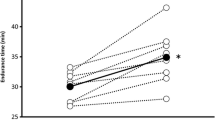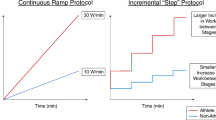Summary
Recent evidence suggests that exercise-induced hypoxemia (EIH) may occur in healthy trained endurance athletes. However, at present, no data exist to describe the regularity of EIH in athletes or non-athletes. Therefore, the purpose of the present investigation was to determine the incidence of EIH during exercise in healthy subjects varying in physical fitness. Subjects (N=68) performed an incremental cycle ergometer test to volitional fatigue with percent arterial oxyhemoglobin saturation (%SaO2) measured min-by-min. For the purpose of data analysis subjects were divided into three groups according to their level of physical training: 1) untrained (N=16), 2) moderately trained (N=27), and 3) elite highly trained endurance athletes (N=25). EIH was defined as a %SaO2 of ≤91% during exercise. EIH did not occur in any of the untrained subjects or the moderately trained subjects. However, EIH occurred in 52% of the highly trained endurance athletes tested and was highly reproducible (r=0.95; P<0.05). These findings further confirm the existence of EIH in healthy highly trained endurance athletes and suggests a rather high incidence of EIH in this healthy population. Hence, it is important that the clinician or physiologist performing exercise testing in elite endurance athletes recognize that EIH can and does occur in the elite endurance athlete in the absence of lung disease.
Similar content being viewed by others
References
Astrand P, Rodahl K (1986) Textbook of work physiology. McGraw-Hill, New York, pp 238
Cotes J (1975) Lung function. Blackwell Scientific Publications Oxford, pp 241–259
Dempsey J, Hanson P, Henderson K (1984) Exercise-induced arterial hypoxemia in healthy persons at sea level. J Physiol (Lond) 355:161–175
Hansen J, Casaburi R (1987) Validity of ear oximetry in clinical exercise testing. Chest 91:333–337
Holmgren A, Linderholm H (1958) Oxygen and carbon dioxide tensions of arterial blood during heavy and exhaustive exercise. Acta Physiol Scand 44:203–215
Klein J, Forster H, Steward R, Wu A (1980) Hemoglobin affinity for oxygen during short term exhaustive exercise. J Appl Physiol 48:236–242
Ogilvie C, Forster R, Blakemore W, Morton J (1957) A standardized breathholding technique for the clinical measurement of the diffusing capacity of the lung for carbon monoxide. J Clin Invest 36:1–17
Poppius H, Viljanen A (1977) A new oximeter for assessment of exercise-induced hypoxemia in patients with pulmonary diseases. Scand J Resp Dis 58:297–283
Powers S, Williams J (1987) Exercise-induced hypoxemia in highly trained athletes. Sports Med 4:46–53
Powers S, Dodd S, Woodyard J, Beadle R, Church G (1984) Alterations in hemoglobin saturation during incremental arm and leg exercise. Br J Sports Med 18:212–216
Powers S, Dodd S, Freeman J, Samson H (1988) Validity of pulse oximetry to predict %SaO2 during exercise. Abstr FASEB J 2:A520
Rebuck A, Chapman K, D'Urzo A (1983) The accuracy and response characteristics of a simplified ear oximeter. Chest 83:860–864
Ries A, Farrow J, Clausen J (1985) Accuracy of two ear oximeters at rest and during exercise in pulmonary patients. Am Rev Respir Dis 32:685–689
Rowell L, Taylor H, Wand Y, Carlson Y (1964) Saturation of arterial blood with oxygen during maximal exercise. J Appl Physiol 19:284–286
Torre-Bueno J, Wagner P, Saltzman H, Gale G, Moon R (1985) Diffusion limitations in normal humans during exercise at sea level and simulated altitude. J Appl Physiol 58:899–905
Williams J, Powers S, Stuart M (1986) Hemoglobin desaturation in highly trained athletes during heavy exercise. Med Sci Sports Exerc 18:168–173
Author information
Authors and Affiliations
Rights and permissions
About this article
Cite this article
Powers, S.K., Dodd, S., Lawler, J. et al. Incidence of exercise induced hypoxemia in elite endurance athletes at sea level. Europ. J. Appl. Physiol. 58, 298–302 (1988). https://doi.org/10.1007/BF00417266
Accepted:
Issue Date:
DOI: https://doi.org/10.1007/BF00417266




